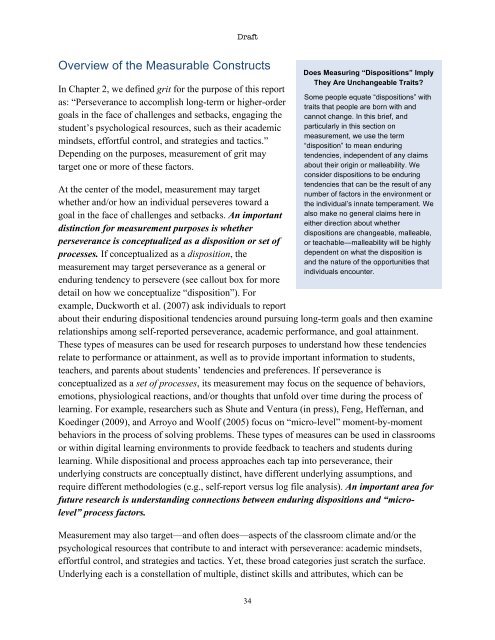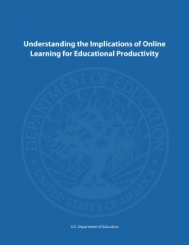Promoting Grit, Tenacity, and Perseverance - U.S. Department of ...
Promoting Grit, Tenacity, and Perseverance - U.S. Department of ...
Promoting Grit, Tenacity, and Perseverance - U.S. Department of ...
Create successful ePaper yourself
Turn your PDF publications into a flip-book with our unique Google optimized e-Paper software.
Draft<br />
Overview <strong>of</strong> the Measurable Constructs<br />
In Chapter 2, we defined grit for the purpose <strong>of</strong> this report<br />
as: “<strong>Perseverance</strong> to accomplish long-term or higher-order<br />
goals in the face <strong>of</strong> challenges <strong>and</strong> setbacks, engaging the<br />
student’s psychological resources, such as their academic<br />
mindsets, effortful control, <strong>and</strong> strategies <strong>and</strong> tactics.”<br />
Depending on the purposes, measurement <strong>of</strong> grit may<br />
target one or more <strong>of</strong> these factors.<br />
At the center <strong>of</strong> the model, measurement may target<br />
whether <strong>and</strong>/or how an individual perseveres toward a<br />
goal in the face <strong>of</strong> challenges <strong>and</strong> setbacks. An important<br />
distinction for measurement purposes is whether<br />
perseverance is conceptualized as a disposition or set <strong>of</strong><br />
processes. If conceptualized as a disposition, the<br />
measurement may target perseverance as a general or<br />
enduring tendency to persevere (see callout box for more<br />
detail on how we conceptualize “disposition”). For<br />
example, Duckworth et al. (2007) ask individuals to report<br />
Does Measuring “Dispositions” Imply<br />
They Are Unchangeable Traits?<br />
Some people equate “dispositions” with<br />
traits that people are born with <strong>and</strong><br />
cannot change. In this brief, <strong>and</strong><br />
particularly in this section on<br />
measurement, we use the term<br />
“disposition” to mean enduring<br />
tendencies, independent <strong>of</strong> any claims<br />
about their origin or malleability. We<br />
consider dispositions to be enduring<br />
tendencies that can be the result <strong>of</strong> any<br />
number <strong>of</strong> factors in the environment or<br />
the individual’s innate temperament. We<br />
also make no general claims here in<br />
either direction about whether<br />
dispositions are changeable, malleable,<br />
or teachable—malleability will be highly<br />
dependent on what the disposition is<br />
<strong>and</strong> the nature <strong>of</strong> the opportunities that<br />
individuals encounter.<br />
about their enduring dispositional tendencies around pursuing long-term goals <strong>and</strong> then examine<br />
relationships among self-reported perseverance, academic performance, <strong>and</strong> goal attainment.<br />
These types <strong>of</strong> measures can be used for research purposes to underst<strong>and</strong> how these tendencies<br />
relate to performance or attainment, as well as to provide important information to students,<br />
teachers, <strong>and</strong> parents about students’ tendencies <strong>and</strong> preferences. If perseverance is<br />
conceptualized as a set <strong>of</strong> processes, its measurement may focus on the sequence <strong>of</strong> behaviors,<br />
emotions, physiological reactions, <strong>and</strong>/or thoughts that unfold over time during the process <strong>of</strong><br />
learning. For example, researchers such as Shute <strong>and</strong> Ventura (in press), Feng, Heffernan, <strong>and</strong><br />
Koedinger (2009), <strong>and</strong> Arroyo <strong>and</strong> Woolf (2005) focus on “micro-level” moment-by-moment<br />
behaviors in the process <strong>of</strong> solving problems. These types <strong>of</strong> measures can be used in classrooms<br />
or within digital learning environments to provide feedback to teachers <strong>and</strong> students during<br />
learning. While dispositional <strong>and</strong> process approaches each tap into perseverance, their<br />
underlying constructs are conceptually distinct, have different underlying assumptions, <strong>and</strong><br />
require different methodologies (e.g., self-report versus log file analysis). An important area for<br />
future research is underst<strong>and</strong>ing connections between enduring dispositions <strong>and</strong> “microlevel”<br />
process factors.<br />
Measurement may also target—<strong>and</strong> <strong>of</strong>ten does—aspects <strong>of</strong> the classroom climate <strong>and</strong>/or the<br />
psychological resources that contribute to <strong>and</strong> interact with perseverance: academic mindsets,<br />
effortful control, <strong>and</strong> strategies <strong>and</strong> tactics. Yet, these broad categories just scratch the surface.<br />
Underlying each is a constellation <strong>of</strong> multiple, distinct skills <strong>and</strong> attributes, which can be<br />
34
















